AUGUSTE RODIN
- his life, his work (4)
|
|
|
|
|
1884
|
 National subscription for a monument of 'The Burghers of Calais'; Rodin wins the competition and obtains the commission by the town
of Calais after sending in his first maquette. National subscription for a monument of 'The Burghers of Calais'; Rodin wins the competition and obtains the commission by the town
of Calais after sending in his first maquette. 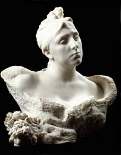 Rodin is awarded the
contract and is asked to produce a second maquette. Rodin is awarded the
contract and is asked to produce a second maquette.
This year, he also works on further portrait busts (H. Rochefort, Mme Roll, W.
Henley, A. Proust, Mme Vicuna und Camille Claudel).
He rents a larger studio at Rue de Vaugirard.
'The Age of Bronze' is placed in the Jardin du Luxembourg.
Exhibition e.g. in the Royal Academy in London.
|
|
1885
|
Death of Victor Hugo on 15 May.
|
|
1885
|
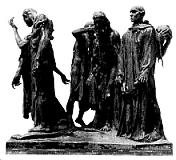 Assisted by Camille, he mainly works on 'The Burghers of Calais' – first nude studies of the six figures,
dressed afterwards - and on 'The Gates of
Hell'. The second maquette of the 'Burghers',
presented in July 1885, triggers a new discussion and many changes are
proposed. Rodin, however, refuses to use a conventional pyramidal
construction, centering around a single heroe; instead, he puts the six men on the same level, each of them
expressing his
own deeply human reaction to the cruel fate that binds them together. The over-lifesize bronze cast, weighing more than 2,200 kg, can
only be completed and installed in 1895, ten years later. Assisted by Camille, he mainly works on 'The Burghers of Calais' – first nude studies of the six figures,
dressed afterwards - and on 'The Gates of
Hell'. The second maquette of the 'Burghers',
presented in July 1885, triggers a new discussion and many changes are
proposed. Rodin, however, refuses to use a conventional pyramidal
construction, centering around a single heroe; instead, he puts the six men on the same level, each of them
expressing his
own deeply human reaction to the cruel fate that binds them together. The over-lifesize bronze cast, weighing more than 2,200 kg, can
only be completed and installed in 1895, ten years later.
He executes his first portrait of Camille: 'Aurore'.
|
|
1886
|
Rodin moves to 71 Rue de Bourgogne with Rose.
A financial crisis in Calais hinders the task of the committee.
Exhibition of some sculptures in the Gallery Georges Petit in Paris at the
5th International Exhibition of Painting and Sculpture.
He receives the commission for a monument of Benjamin Vicuna Mackenna and General Patricio Lynch for Santiago in Chile.
Camille spends the summer in England with her friend Jessie Lipscomb. In
May, they stay in Peterborough. Rodin travels to London, hoping to meet
Camille, addressing Jessie as an intermediary, but when he arrives in Peterborough
and Jessie sings a Scottish ballad, Camille is irritated and breaks up the evening.
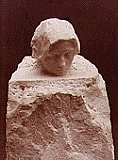 In August, Camille spends a holiday with Jessie's family on the Isle of
Wight. Rodin proposes to meet in Calais, but Camille declines. By making
herself unavailable, she drives Rodin into despair again. In August, Camille spends a holiday with Jessie's family on the Isle of
Wight. Rodin proposes to meet in Calais, but Camille declines. By making
herself unavailable, she drives Rodin into despair again.
He writes and signs a letter, dated 12 October 1886, evidently dictated by Camille, in which Rodin
promises to give up all contact to his former models and other women, and to marry
Camille. This curious contract never is fulfilled; their liaison remains
inofficial.
Several portrayals of Camille, e.g. 'La Pensée'. Later, Rodin will use
Camille's features in several works, for example 'La France' and 'St.
George'.
|
|
1884-89
|
He works on illustrations for Baudelaire's 'Fleurs du Mal'
for Edition Gallimard. He regrets that his salary is only 2,000 Francs so that he
cannot dedicate enough time to these drawings; many of them in
fact are remakes of earlier sketches.
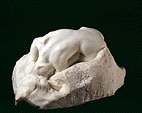 During this period, Rodin creates a series of love couples, torn apart
between despair and desire, lust and shame, reflecting his
"impossible" relationship with Camille: 'Fugitive Love' (1884),
'Avarice and Lust' (1885), 'Faun and Nymph' (1886), 'Paolo &
Francesca' (1887), 'Death of Adonis' (1888) and 'Eternal Idol'
(1889). The single figures express the same mixture of pain and passion: 'Fall of Icarus' (1885), 'Danaid' (1885), 'Prodigal Son'
(1886), 'Centauress' (1887 or 1889). During this period, Rodin creates a series of love couples, torn apart
between despair and desire, lust and shame, reflecting his
"impossible" relationship with Camille: 'Fugitive Love' (1884),
'Avarice and Lust' (1885), 'Faun and Nymph' (1886), 'Paolo &
Francesca' (1887), 'Death of Adonis' (1888) and 'Eternal Idol'
(1889). The single figures express the same mixture of pain and passion: 'Fall of Icarus' (1885), 'Danaid' (1885), 'Prodigal Son'
(1886), 'Centauress' (1887 or 1889). 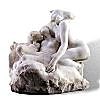
Camille acts as his model, mixes the gypsum, enlarges his maquettes and creates
important parts of his sculptures, especially hands.
Moreover, she loves to
carve the marble - a task Rodin mostly passes on to his assistants.
Rodin introduces her to the foremost art crtitcs in Paris, who start to
support her work as well: Octave Mirbeau, George Geffroy and the young Swiss poet
Mathias Morhardt. Because Rodin almost always asked her advice in artistic
matters, Morhardt, who knew Camille very closely, already
pointed out that Rodin and Camille often behaved like brother and sister.
Despite an age difference of 24 years, Camille
manages to occupy the role of the older sister; Rodin acts as the younger,
talented brother, whom she tries to direct much the very same way she
used to push her brother Paul and her family around.
|
|
1887
|
Rodin receives the Cross of the Chevalier of the Legion
of Honor.
At an exhibition, he shows three already completed figures of 'The
Burghers Of Calais' in the Gallery Georges Petit together
with 'The Lovers' and fragments of 'The Gates of Hell'.
|
|
1888
|
Camille's parents, who had invited Rodin and 'his wife' Rose to the
family home in Villeneuve, now learn about the true relationship between
the artist and their daughter. Because of the resulting tension with her
moralist mother, Camille has to leave the house.
Together with Camille, Rodin rents a studio in
the Folie Neubourg (also called Folie le Prestre or Folie
Payen
), a little old castle at 68 Boulevard d´Italie, that already had
been the love nest of George Sand and Alfred de Musset.
Camille
still hopes she can replace Rose, who does hardly participate in Rodin's
social and intellectual life and rather functions as a kind of
housekeeper.
 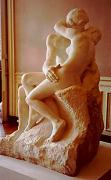 Camille creates a portrait bust of Rodin. Rodin is an impatient sitter;
because of the long breaks between the sittings the clay model dries and
cracks, so that the work has to be saved by means of a plaster cast. Camille also
creates 'Sakountala', a love couple embodying the same intense
adoration as 'Eternal Idol' created by Rodin one year later. Rodin, as a
member of the jury, uses his influence to award Camille's work an
honourable mention.
Camille creates a portrait bust of Rodin. Rodin is an impatient sitter;
because of the long breaks between the sittings the clay model dries and
cracks, so that the work has to be saved by means of a plaster cast. Camille also
creates 'Sakountala', a love couple embodying the same intense
adoration as 'Eternal Idol' created by Rodin one year later. Rodin, as a
member of the jury, uses his influence to award Camille's work an
honourable mention.
The state commissions a marble replica of 'The Kiss' for 20.000 Francs;
Rodin also works on 'The
Sin', 'The Ban' and 'Big Bathing, crouching'.
|
|
1889
|
Rodin sends two young sculptresses to Camille Claudel to
have lessons from her, but Camille finally turns down the request. Jessie
Lipscomb, returning to France in March to have more sculpture lessons from
Rodin, already knows about tensions between Camille and Rodin.
On 17 July, Rodin leaves for a vacation in Spain together
with Camille. Most of his friends do not know where he has gone. According
to Butler, Rodin and Camille tried to keep their
travels secret, anticipating the reaction of Rose and of Camille's family;
Reine-Marie Paris, however, believes that at least Rose was informed.
Although Rodin and Rose still live together at 71 Rue de Bourgogne, Rodin pays
little attention to his long-time companion.
Rodin exhibits 36 works together with his friend Claude Monet at
the Gallery Georges Petit, including 'The Burghers of Calais'. At
the hanging, it comes to a clash between the two artists; Monet complains
that his paintings are completely obscured by Rodin's sculptures. But the exhibition
is successful for Rodin and he wins more defenders of his work.
Rodin is a member of the Jury for the Exposition Universelle and is also
elected for the Committée du Salon des Artistes Francais.
The state commissions him for a monument to Claude Lorrain in Nancy and
for a monument to Victor Hugo, to be placed in the Panthéon
in Paris.
|


|